5—
Pitch Structure:
A Russian Heritage
I was guided by no system whatever in Le Sacre du printemps. When I think of the other composers of that time who interest me—Berg, who is synthetic (in the best sense), Webern, who is analytic, and Schoenberg, who is both—how much more theoretical their music seems than Le Sacre; and these composers were supported by a great tradition, whereas very little immediate tradition lies behind Le Sacre du printemps. I had only my ear to help me. I heard and I wrote what I heard. I am the vessel through which Le Sacre passed.
Stravinsky and Craft, Expositions and Developments , pp. 147-48
To judge from the Autobiography and the later books of "conversation" with Robert Craft, Stravinsky harbored mixed feelings about his early years of apprenticeship with Rimsky-Korsakov.[1] At twenty-three years of age in 1905, he seems greatly to have liked and admired the patient, methodical ways of his teacher. Conducted twice a week and lasting for about three years, his lessons consisted in the main of assignments in orchestration. At the outset, piano reductions of Rimsky's operas were orchestrated and compared with the master's originals, and the young student must by these means have familiarized himself with nearly all of Rimsky's
[1] Igor Stravinsky, An Autobiography (New York: Norton, 1962), pp. 20–25; Igor Stravinsky and Robert Craft, Memories and Commentaries (Berkeley: University of California Press, 1981), pp. 54–60; Igor Stravinsky and Robert Craft, Expositions and Developments (Berkeley: University of California Press, 1981), pp. 41, 43–45.
scores. More significantly, his apprenticeship brought with it a recognition of both talent and serious intent, encouragement which seems to have been lacking within the confines of his immediate family circle. Rimsky had other composition students at the time, among whom Maximilian Steinberg, soon to become Rimsky's son-in-law, seems to have been regarded as the most promising. Yet there can be no overstating the spiritual and musical significance of this early bond. Stravinsky became a regular member of the Rimsky-Korsakov household, and for a time enjoyed the close friendship of Rimsky's two sons, Vladimir and Andrei. (The Firebird is dedicated to Andrei Rimsky-Korsakov.) Something like a father-son relationship must also gradually have transcended the teacher-pupil formality, and Rimsky was at this time, as Stravinsky later confessed, quite simply "sans reproche ."[2]
As these years drew to a close, however (Rimsky died in June, 1908), Stravinsky may well have become increasingly conscious of his teacher's limitations as a composer and instructor of composition. Although Rimsky was well versed in harmony and practical orchestral writing, his knowledge of composition itself "was not at all what it should have been."[3] Rimsky had in fact become something of a reactionary in his later years. He disliked the music of Debussy, and his retort following a performance of the latter's music has become legend: "Better not to listen to him; one runs the risk of getting accustomed to him, and one would end up by liking him."[4] Stravinsky, on the other hand, had become increasingly sympathetic to Debussy's music, as the opening pages of The Nightingale , composed in 1908–09 and in obvious imitation of "Nuages" in Nocturnes , clearly demonstrate. The influence can likewise be felt in the early cantata Faun and Shepherdess (1906), whose whole-tone passages affronted Rimsky's conservative bent.[5] Stravinsky would later quip that Rimsky's own "modernism" had at this time consisted of little more than "a few flimsy enharmonic devices."[6]
In both his operas and his symphonic poems Rimsky had drawn a distinction between the magical scenes or characters and the real or natural ones by complementing the former with music that was chromatic and instrumentally decorative and the latter with diatonic folk material (borrowed or pseudo) that was set rather simply in comparison. The chromatic side of this approach was often non-tonal; that is, it consisted of harmonic and melodic patterns that implied referential collections with interval orderings (scales) other than that of the diatonic collection and its familiar major and minor modes. The resultant scales were often symmetrical, outlining an (0, 4, 8) major-third or (0, 3, 6, 9) minor-third partitioning of the octave.
The general approach can be traced back to Mikhail Glinka. In Ruslan and Lud-
[2] Stravinsky and Craft, Memories and Commentaries , p. 57.
[3] Ibid.
[4] Stravinsky, An Autobiography , p. 18.
[5] Stravinsky and Craft, Memories and Commentaries , p. 59.
[6] Ibid.
milla (1842), the material that accompanies the evil sorcery of Chernomor in Act IV is a descending whole-tone scale, which, unadorned, is subsequently transposed down a fourth. Shown in Example 45, these implications are situated within a securely fastened diatonic framework whose tonal, E-major focus is never seriously undermined. Even the whole-tone transposition is in imitation of the tonic-dominant relationship.
Somewhat more elaborate is the passage shown in Example 46c from the overture to the opera. Here, a whole-tone scale on D descends in the bass, while major triads on D, B





















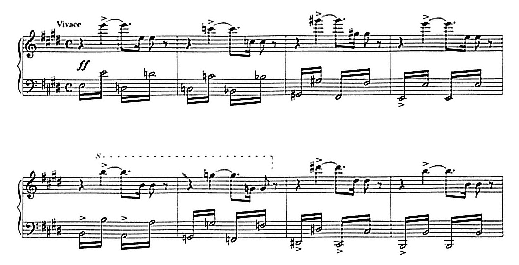
Example 45:
Ruslan and Ludmilla
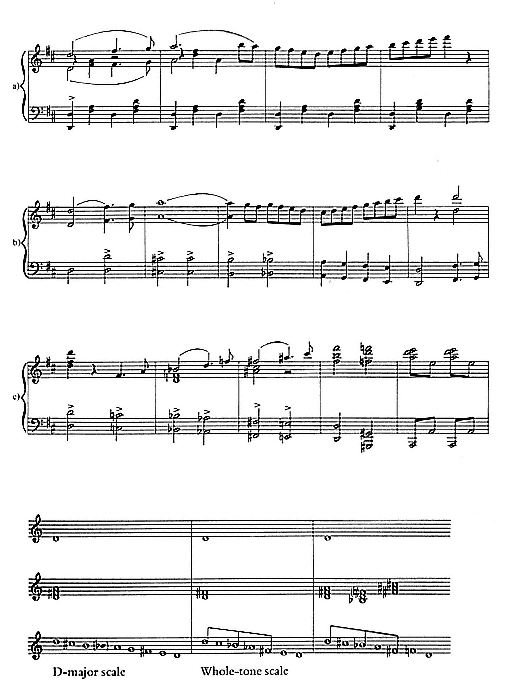
Example 46:
Ruslan and Ludmilla , Overture
Given the obvious classical credentials of Glinka's opera, some of these deductions may seem a bit fussy. The overture follows the Italian model of the period in both form and general character. And the points of intersection are, as noted already, highly conspicuous: in Example 46c, the descending whole-tone scale is a variant of the tonal, chromatic descent earlier in Example 46b, while, motivically speaking, the (D, B


Rimsky's symmetrical patterns, although occasionally derived from the whole-tone scale or the (0, 4, 8) relation, spring more persistently from what has become known as the octatonic pitch collection .[7] This is a set of eight distinct pitch classes which, confined to the octave and arranged in scale formation, yields the symmetrical interval ordering of alternating half and whole steps or whole and half steps. (In his autobiography, Rimsky identified the scale according to its half step-whole step ordering.)[8] And apart from the diminished-seventh chord, there are two principal schemes of partitioning, the first of these harmonic in conception, the second exclusively melodic: in harmony, a partitioning or slicing up of the collection (with overlapping pitch content) by major and minor triads and dominant-seventh chords, and, in melody, a partitioning by the so-called minor or Dorian tetrachord whose 2-1-2 or whole step-half step-whole step interval ordering yields a pitch numbering of (0 2 3 5), reading up or down. (Conventional terminology is employed for purposes of identification. The larger symmetrical sets preclude tonally functional relations, which are founded referentially on the major-scale ordering of the diatonic set.)
In the passage from Sadko (1896) in Example 47, the major triads and dominant sevenths partition the octatonic octave at C, E

















[7] The first to examine octatonic pitch relations systematically in Stravinsky's music was Arthur Berger in his "Problems of Pitch Organization in Stravinsky," in Benjamin Boretz and Edward T. Cone, eds., Perspectives on Schoenberg and Stravinsky (New York: Norton, 1972), pp. 123–54. Berger's conclusions are further developed in Pieter C. van den Toorn, The Music of Igor Stravinsky (New Haven: Yale University Press, 1983).
[8] My Musical Life , trans. Judah A. Joffee (New York: Tudor, 1935), p. 72.
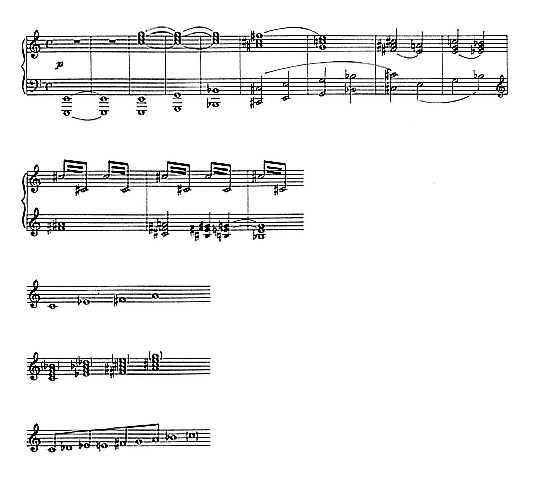
Example 47:
Sadko
The octatonic passages in Stravinsky's early works do not differ significantly from those of Rimsky. In fact, The Firebird adheres closely to the dual approach outlined above. The music of King Kastchei and of the magical scenes generally is accompanied by symmetrical patterns (often octatonic, as in the Introduction and, later, at the beginning of the Danse infernale ), while the natural or sentimental scenes are for the most part diatonic in character (as in the Khorovod and the Finale). Moreover, a pattern of alternating major and minor thirds in the Introduction is clearly derived from Rimsky's Kastchei the Immortal ; compare, in Example 49, the two passages from Scene I in Rimsky's opera to the figuration at mm. 1–9 in The Firebird , Example 50.[9]
[9] For a more detailed analysis of The Firebird introduction see van den Toorn, The Music of Igor Stravinsky , pp. 1–17. The Kastchei-Firebird connection is pursued at greater length in Richard Taruskin, "Chernomor to Kastchei: Harmonic Sorcery; or, Stravinsky's 'Angle,'" Journal of the American Musicological Society 38, 1 (1985): 72–142.
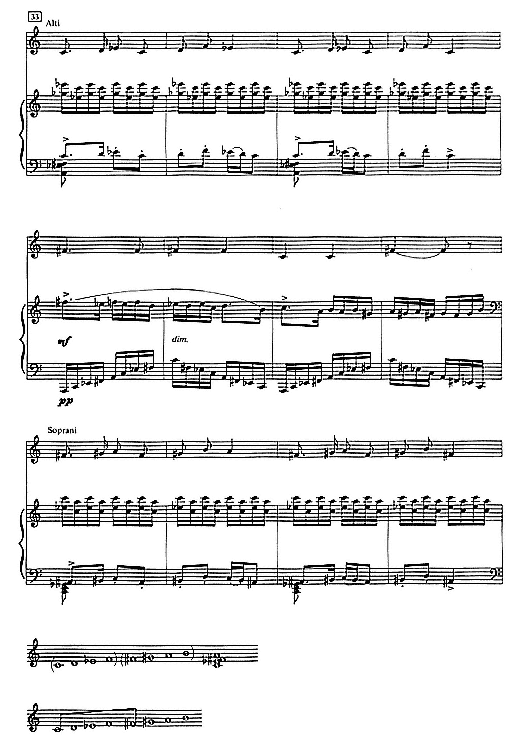
Example 48:
Kastchei the Immortal
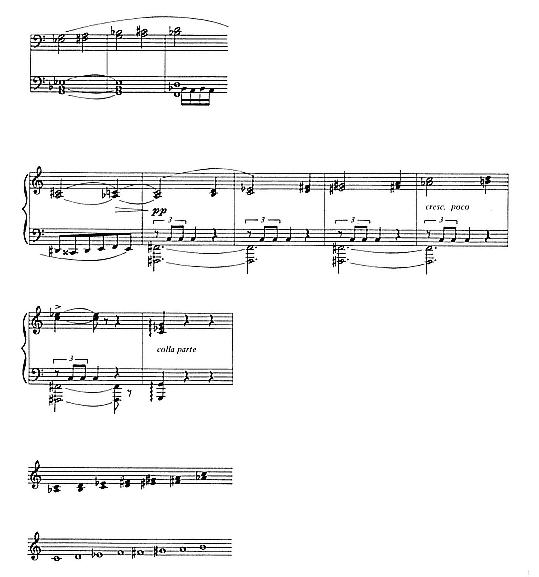
Example 49:
Kastchei the Immortal
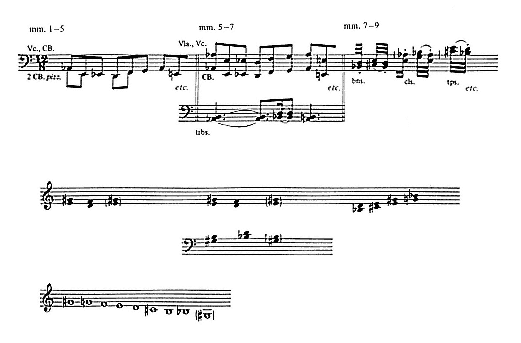
Example 50:
The Firebird
More specifically, too, the octatonic vocabulary in these early Stravinsky works is in large part drawn from Rimsky. Completed just before Rimsky's death, the Scherzo fantastique (1908) contains passages that exemplify both the harmonic and melodic conceptions as detailed above. Three (0, 3, 6, 9) symmetrically defined successions of triads and dominant sevenths are shown in Example 51, while a succession of overlapping (0 2 3 5) tetrachords appears in Example 52. And these are only a few of the many octatonic sequences that may readily be inferred from the Scherzo . Like a whirlwind, the piece moves from one such sequence to the next, often on an explicit basis, wholly unimpaired by "outside" interference. Moreover, the emphasis on the (B C D D










More directly to the point here: all of these formulae are as pertinent to The Rite as they are to the early Scherzo fantastique and The Firebird . Indeed, The Rite is one of the most thoroughly octatonic of Stravinsky's works, rivaled in the explicit nature
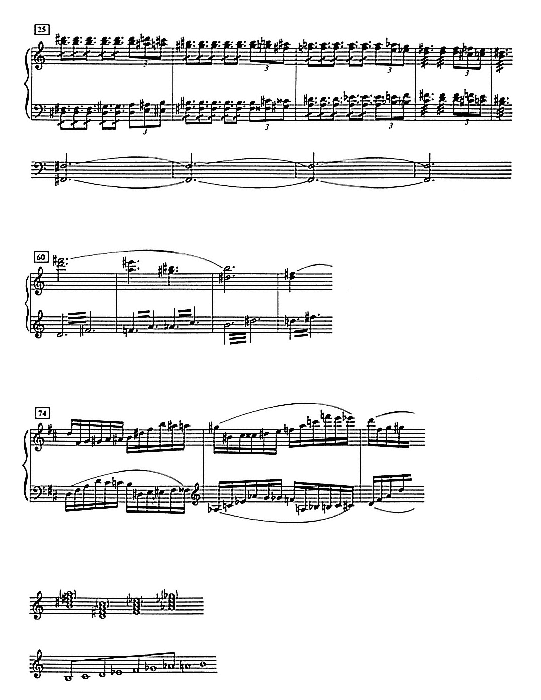
Example 51:
Scherzo fantastique
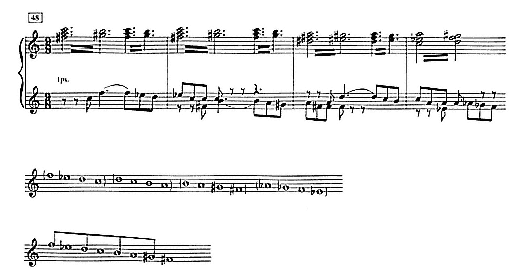
Example 52:
Scherzo fantastique
and persistence of this reference only by pieces such as the cited Scherzo, Petrushka , and, much later, the Symphony of Psalms (1930) and the Symphony in Three Movements (1945). And to an astonishing degree, the vocabulary that informs this referential commitment remains intact: triads, dominant sevenths, and (0 2 3 5) tetrachords. The distinction rests primarily with the technique of superimposition. In The Rite , the (0, 3, 6, 9) symmetrically defined units no longer succeed one another, harmlessly, as they do in the operas of Rimsky or in the early Stravinsky passages cited above. These units are now superimposed—played simultaneously. And this is an invention from which startling implications accrue not only in pitch organization but, as a consequence, in rhythm and instrumental design as well. It radically alters the conditions of octatonic confinement, opens up a new dimension in octatonic thought that Stravinsky, beginning with Petrushka and The Rite , was to render peculiarly his own.
Thus, in Example 53, from the "Ritual of Abduction" in The Rite , the (0, 3, 6, 9)—related dominant sevenths on C, E





True enough, as illustrations of earlier formulae these two passages in Examples 53 and 54 are relatively straightforward. The Rite encompasses in addition a strong diatonic current, evident particularly in the dance movements of Part I,
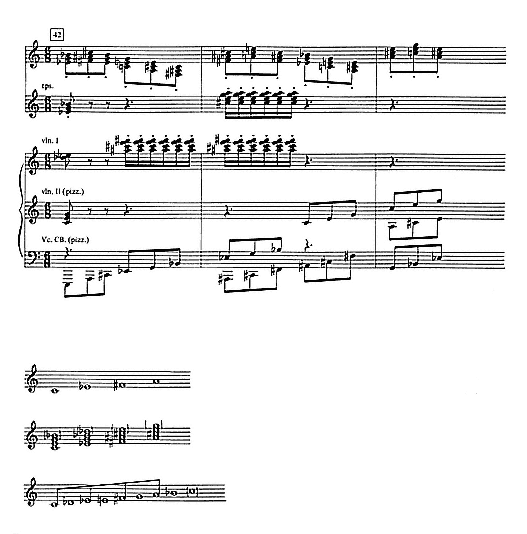
Example 53:
"Ritual of Abduction"
along with significant chromatic vertical structures which, if not entirely unrelated to the octatonic framework, are at least locally non-octatonic in appearance. (See the ornamental F




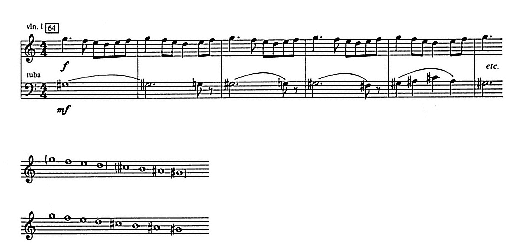
Example 54:
"Ritual of the Rival Tribes"
configurations in the music of Maximilian Steinberg.[10] Steinberg's Prélude symphonique (1908), composed, like Stravinsky's Chant funèbre (1908),[11] in memory of Rimsky-Korsakov, contains Petrushka -like chords that are undoubtedly among the very first of their kind. Midway into this piece the (B D


Indeed, the peculiar "dissonance" of The Rite can often be traced to the 0–11 or major-seventh span of the octatonic scale's 2-1 or whole step–half step ordering; see, in Example 54 from the "Ritual of the Rival Tribes," the metric accentuation of the G




[11] The score of this early Chant funèbre for wind instruments was unfortunately lost during the First World War. See Stravinsky and Craft, Memories and Commentaries , p. 59.
harsh, and it accounts in large measure for the consistency that may be inferred throughout on the part of the octatonic component.
Pierre Boulez once described The Rite as a piece in which a "vertical chromaticism" stood opposed to a "horizontal diatonicism."[12] By this he meant that while the vertical alignment is often chromatic, the individual parts are in themselves often simple and diatonic. Here, of course, the just-noted 0–11 interval span may define the "vertical chromaticism," while the (0 2 3 5) tetrachord often accounts for the simple "diatonicism" of the principal parts. And the "conflict" which has always seemed such an essential aspect of The Rite can no doubt revealingly be defined in terms of a vertical-horizontal, chromatic-diatonic opposition, as can, apropos of its "horizontal diatonicism," the fact that the term dissonance may yet seem appropriate even if conventional considerations of treatment no longer apply.[13]
Beyond this, however, Boulez's description quickly became deceptive. For as can be seen from the illustrations in this chapter, the (0 2 3 5) tetrachord is a subset of both the octatonic and the diatonic collections. In fact, by way of this neutrality, it often serves as an articulative connecting link between blocks or sections of material that are referentially distinct in this respect. Hence, too, the "conflict" or "opposition" in pitch structure has as much to do with the symmetrical conditions of octatonic confinement, and with the articulation of the octatonically conceived 0–11 vertical interval span, as with the vertical-horizontal or chromatic-diatonic oppositions noted by Boulez.
In a similar vein, Boulez drew attention to the techniques of superimposition, juxtaposition, and repetition; these, he averred, were the key to Stravinsky's art.[14] Curiously, however, these references were never amplified by a study of pitch structure that is in any way comparable to his analysis of rhythm, and many of his more concrete observations are seriously misleading. Although cognizant of the vocabulary of triads, dominant sevenths, and (0 2 3 5) tetrachords, and of the static implications that arise from the superimposition of this vocabulary, Boulez discussed these matters in a generally unsympathetic tone. Superimposition was viewed as an "irreducible aggregation," a "coagulation" that creates for the superimposed fragments and chords a "false counterpoint," all of this "eminently static in the sense that it coagulates the space-sound into a series of unvarying stages."[15] More significantly, "coagulation" was defined solely in terms of "complexities grafted onto the old organization,"[16] "complexities" that in turn constitute little more than a "surcharge of an existent [tonal] language."[17] In other words, it was the conventional diatonic (even tonal) identification of the triads, dominant sev-
[12] Pierre Boulez, Notes of an Apprenticeship , trans. Herbert Weinstock (New York: Knopf, 1968), p. 74.
[13] See Arnold Whittall, "Music Analysis as Human Science? Le Sacre du Printemps in Theory and Practice," Music Analysis 1, 1 (1982): 33–34. The idea of a "conflict" being tied to a dissonance-consonance distinction is central to Whittall's thesis, although he fails to define the specific terms of this relationship.
[14] Boulez, Notes of an Apprenticeship , pp. 61–62.
[15] Ibid., pp. 249–50.
[16] Ibid., p. 74.
[17] Ibid., p. 250.
enths, and (0 2 3 5) tetrachords that attracted his attention. He overlooked the new referential status, the octatonically conceived nature of the vocabulary, of the superimposition, "vertical chromaticism" or "coagulation." Similarly, the notion of "polarity," of an ambiguity in pitch-class priority, was interpreted not in terms of the (0, 3, 6, 9) symmetrically defined partitioning elements of the octatonic collections (as is often conspicuously the case in The Rite and indeed in much of Stravinsky's music), but, anachronistically again, in terms of a subdominant-tonic-dominant relation.[18]
Indeed, Boulez's critique revolved around an unsettling impasse. On the one hand, the vertical structures, being static, "easily manageable materials," allow for an "extreme boldness" in the rhythmic design (which for Boulez is the real treasure of The Rite ).[19] On the other hand, these same vertical structures, which comprise the harmonic vocabulary and syntax of The Rite , are at the heart of the "Stravinsky Impossibility," of a "miserable insolvency" in compositional technique that rendered the neoclassical change of heart, the meek "nostalgia" of Stravinsky's neoclassical ways, all but inevitable.[20] Far from an aesthetic volte-face, for Boulez neoclassicism was an escape, a move of practical necessity triggered by the backwardness of the composer's harmonic and melodic materials. The idea of Stravinsky having lacked a "melodic gift" and of his consequent dependence on borrowed "stuff" also figures in Boulez's account, although this argument receives greater emphasis in the criticism of Cecil Gray, Constant Lambert, and Theodor Adorno, as surveyed earlier in Chapter 3.
Of course, triadic succession of the kind illustrated in the octatonic passages by Rimsky, Steinberg, and Stravinsky cited above does have a place in the tonal tradition. In Example 55 a passage from the second movement of Brahms's Third Symphony serves as illustration. Here, a transition leading back to the principal C-major theme is composed of a chromatic sequence that includes dominant-seventh chords on F and D; the second of these chords, serving as V-of-V, resolves to the tonic. The complete (0, 3, 6, 9) symmetrical sequence, with dominant sevenths on F, D, B, and A



[18] Ibid., p. 74.
[19] Ibid., p. 75.
[20] Ibid., pp. 14, 247.

Example 55:
Third Symphony (Brahms)
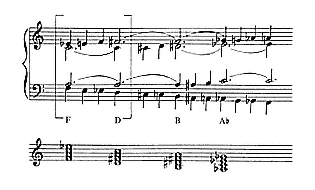
Example 56
On a more elementary level, the individual progressions in Examples 55 and 56 figure among the familiar "irregular resolutions" of the dominant-seventh chord. In Example 57, the dominant seventh on F is followed "irregularly" or "deceptively" by the dominant seventh of the submediant (in other words, down one notch in the (0, 3, 6, 9) minor-third cycle). And with proper voice-leading intact, this was of course standard fare from the Baroque era through the nineteenth century, available in the secondary-dominant realm and with all manner of variety in chordal disposition.
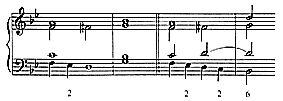
Example 57
Still, it is just this kind of associative factor, of a link between the tonal tradition of "enharmony" and the chromatic patterns of Rimsky-Korsakov and his school, that enables us to move quite smoothly from Boulez's comments on Stravinsky (Stravinsky's mere "surcharge of an existent [tonal] language") to Stravinsky's earlier-noted remarks on Rimsky-Korsakov. For it is altogether probable that when Stravinsky dismissed his teacher's "modernism" as having consisted of little more than "a few flimsy enharmonic devices," a variant of the tonal, enharmonic conception of the (0, 3, 6, 9) minor-third cycle, as demonstrted in Examples 55 and 56, lay somewhere in the back of his mind. True, according to his own testimony, Rimsky was conscious of the octatonic collection as a cohesive frame of reference, and he followed through with its full (0, 3, 6, 9) symmetrical potential on an explicit and unimpaired basis. (See Example 47 from Sadko .) But Rimsky did not superimpose, nor did he juxtapose à la Stravinsky. Consequently, owing to triadic succession and conventional voice-leading, tonally conceived enharmony may have been—and may still be—as apparent as "octatonic accountability."
So, too, in his brief dismissal of Rimsky's "modernist" credentials, Stravinsky may well have forgotten both the nature and the scope of his debt.[22] Indeed, not once in his six books of "conversation" with Robert Craft did he mention the octatonic scale, or did he acknowledge, in his "composing with intervals," the frequent confinement of these intervals, in works of the early "Russian," neoclassical, and early serial periods, to the octatonic pitch collection. Given the evidence, however, there can be little question but that Stravinsky, like his predecessors, remained conscious of the octatonic collection as a constructive and referential factor. And it is toward a proper definition of these implications that the present analysis of pitch structure will largely be directed.
[22] Stravinsky and Craft, Memories and Commentaries , p. 59.